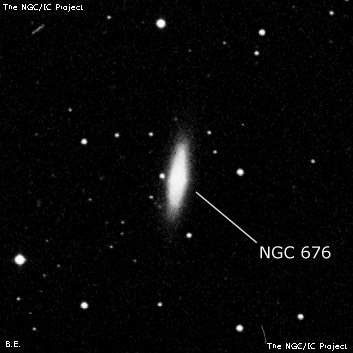
William Herschel discovered NGC 676 = H IV-42 = h151 on 30 Sep 1786 (sweep 607) and recorded "a star with vF branches in the direction of the meridian, each branch about 1' in length; the star about 8 or 9 m; other stars of the same size are free from these branches". Interestingly, he used this example in his 1814 PT paper to argue, not only of the association of the star [very near the center] and the nebula, but that the nebula was brighter near the star because nebulous matter was being drawn by gravity to the star. John Herschel made two observations and logged on 24 Sep 1830, "a *9m with a vF narrow ray of nebulosity; a most curious object." The galaxy was observed 4 times at Birr Castle. On 8 Nov 1876, J.L.E. Dreyer recorded "*9m with pF neb elongated 168.4°, longer on the side of *, concave preceding, convex following."
The 9.5-mag star superimposed at the center is included in the CGCG magnitude (10.5z). Steinicke notes that the separation from centre is only 9", the smallest value of all cases of bright superimposed stars in the NGC!
400/500mm - 17.5" (12/18/89): very unusual appearance as a mag 10 star (BD +5 244) is superimposed on the core! Fairly faint, very elongated 3:1 NNW-SSE, almost even surface brightness except for the bright star. NGC 693 lies 26' NE.
Notes by Steve Gottlieb